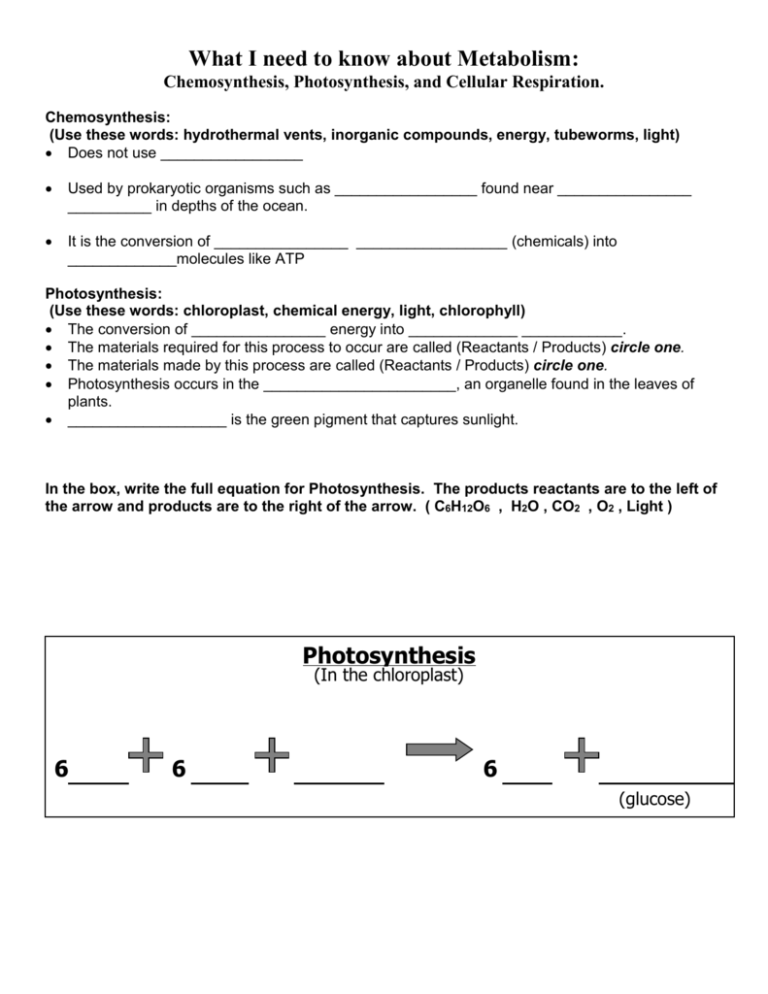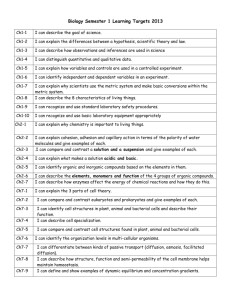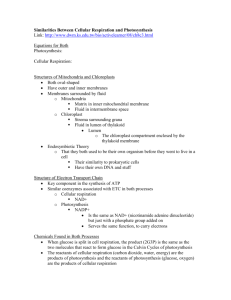What I need to know about Nucleic Acids, Osmosis and Diffusion
advertisement

What I need to know about Metabolism: Chemosynthesis, Photosynthesis, and Cellular Respiration. Chemosynthesis: (Use these words: hydrothermal vents, inorganic compounds, energy, tubeworms, light) Does not use _________________ Used by prokaryotic organisms such as _________________ found near ________________ __________ in depths of the ocean. It is the conversion of ________________ __________________ (chemicals) into _____________molecules like ATP Photosynthesis: (Use these words: chloroplast, chemical energy, light, chlorophyll) The conversion of ________________ energy into _____________ ____________. The materials required for this process to occur are called (Reactants / Products) circle one. The materials made by this process are called (Reactants / Products) circle one. Photosynthesis occurs in the _______________________, an organelle found in the leaves of plants. ___________________ is the green pigment that captures sunlight. In the box, write the full equation for Photosynthesis. The products reactants are to the left of the arrow and products are to the right of the arrow. ( C6H12O6 , H2O , CO2 , O2 , Light ) Photosynthesis (In the chloroplast) 6 6 6 (glucose) Photosynthesis: Identify reactants and products of the Light Dependent and Light Independent Reactions). Fill in the blanks (Water, Glucose, Carbon Dioxide, Oxygen, and Light) Chlorophyll (Chloroplast) H+ ATP Calvin Cycle Rate of Photosynthesis: List abiotic factors that can affect the rate of photosynthesis. 1. 2. 3. 4. 5. What would you measure if you wanted to determine how fast photosynthesis was occurring? If you designed an experiment to test the factors that affect the rate of photosynthesis, what would be your: o Independent variable? __________________ o Dependent Variable? ___________________ o Control Variable? Cellular Respiration: Use these words: anaerobic, mitochondria, lactic acid, glucose, ethyl alcohol, exercise, temperature, ATP, aerobic, Cytoplasm Cellular Respiration converts the stored chemical energy of ____________ into ______________ (energy molecule used by the cell). The two types of cellular respiration are ________________ (with oxygen) and _______________ (without oxygen). The Aerobic process occurs in an organelle called the _________________________. The anaerobic process called fermentation occurs in the cells __________________________. The byproducts of anaerobic respiration are __________________or ____________________. Rate of Respiration: If you designed an experiment to test the rate of respiration: What abiotic factors could affect the rate of cellular respiration? 1. 2. 3. 4. Which of these factors would be a good independent variable? _____________________ What would you measure if you wanted to determine how fast cellular respiration was occurring?______________________________ What would be the dependent variable? Identify Reactants and Products: Use ATP, C6H12O6, O2, H2O, CO2 Cellular Respiration (in the mitochondria) 6 6 6 Relationship between photosynthesis and respiration Photosynthesis produces _______________ and _______________ which are used during cell respiration. Cell respiration produces ___________ and __________ which are used during photosynthesis. The __________________ of one reaction are the _________________ of the other.reaction How can the survival of a snail and a water plant in a closed test tube prove that the two reactions depend on each other? ___________________________________________________________________________ ___________________________________________________________________________ Flow of energy: Use Sunlight, Green plant, Oxygen, Glucose, Animal, ATP, Carbon Dioxide, Water to describe the flow of energy in the environment. Be sure to discuss how energy from the sun ends up as ATP.







